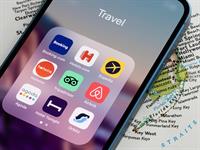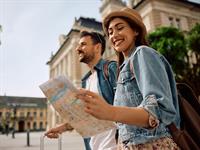PIRMĀ SEMESTRA NOSLĒGUMA TESTI
Using a digital map while traveling.
Prepositions of place.
Revise what you have already learned about Prepositions of place!
What are Prepositions of Place?
When do we use them?
Prepositions of place are words that show the position or location of something in relation to something else. Common prepositions include in, on, at, near, between, behind, above, below, and next to.
We use prepositions of place to describe where things are located, especially when giving directions or describing positions on a map.
How to use them (forms)?
How to use them (forms)?
In
How we use it: When something is inside a space or area.
When: Talking about rooms, containers, or places with boundaries.
Example: The books are in the cupboard.
On
How we use it: When something is resting on a surface.
When: Describing things on top of surfaces.
Example: The keys are on the table.
At
How we use it: To show a specific point or location.
When: When referring to places or addresses.
Example: She is at the bus stop.
Next to
How we use it: To say something is beside or close to something else.
When: Describing nearby locations.
Example: The school is next to the park.
Behind
How we use it: When something is at the back of something else.
When: Describing the position at the back.
Example: The car is behind the house.
Between
How we use it: When something is in the middle of two things.
When: Describing the space separating two objects.
Example: The shop is between the bank and the post office.
Near
How we use it: When something is close to something else, but not necessarily right next to it.
When: Describing proximity.
Example: The bus stop is near the school.
Under
How we use it: When something is directly below something else.
When: Describing a position beneath.
Example: The cat is under the table.
Above
How we use it: When something is higher than something else, but not touching it.
When: Describing a position higher up.
Example: The picture is above the sofa.
In front of
How we use it: When something is facing or before something else.
When: Describing the position ahead of or facing something.
Example: The car is in front of the house.
How we use it: When something is inside a space or area.
When: Talking about rooms, containers, or places with boundaries.
Example: The books are in the cupboard.
On
How we use it: When something is resting on a surface.
When: Describing things on top of surfaces.
Example: The keys are on the table.
At
How we use it: To show a specific point or location.
When: When referring to places or addresses.
Example: She is at the bus stop.
Next to
How we use it: To say something is beside or close to something else.
When: Describing nearby locations.
Example: The school is next to the park.
Behind
How we use it: When something is at the back of something else.
When: Describing the position at the back.
Example: The car is behind the house.
Between
How we use it: When something is in the middle of two things.
When: Describing the space separating two objects.
Example: The shop is between the bank and the post office.
Near
How we use it: When something is close to something else, but not necessarily right next to it.
When: Describing proximity.
Example: The bus stop is near the school.
Under
How we use it: When something is directly below something else.
When: Describing a position beneath.
Example: The cat is under the table.
Above
How we use it: When something is higher than something else, but not touching it.
When: Describing a position higher up.
Example: The picture is above the sofa.
In front of
How we use it: When something is facing or before something else.
When: Describing the position ahead of or facing something.
Example: The car is in front of the house.
Prepositions are always followed by a noun or pronoun.
For example:
The restaurant is on the corner.
The park is next to the museum.
The hotel is in the city centre.
The hotel is near the park.
The museum is behind the library.
The restaurant is on the corner.
The park is next to the museum.
The hotel is in the city centre.
The hotel is near the park.
The museum is behind the library.
Piemērs:
Last weekend, I used my smartphone and a map app app to find my destination. The digital map showed the location of my hotel and the route I needed to take. The distance from my house to the hotel was about five miles. I followed the directions provided by the app to navigate through the city. The app guided me through the streets, showing me which route to take around the busy location. I enjoyed learning about the app because it made my trip convenience and fun. On my way, I saw a beautiful park next to the museum, which was on the map. I also checked the app to see the distance between my hotel and the main attractions. Thanks to the digital map, I didn’t get lost and had a great experience exploring the city.
Word bank:

Picture 1.
App — [æp] — a computer program on a phone or tablet, lietotne
Example: I downloaded a new weather app to check the forecast every morning.

Destination — [ˌdɛstɪˈneɪʃən] — the place where you are going, galamērķis
Example: Our final destination on the road trip is the beautiful beach town.

Picture 2.
Digital — [ˈdɪdʒɪtl] — something that uses computers or electronic devices, digitāls
Digital — [ˈdɪdʒɪtl] — something that uses computers or electronic devices, digitāls
Example: Many museums now have digital exhibits that you can explore online.

Picture 3.
Distance — [ˈdɪstəns] — how far apart two places are, attālums
Example: The distance between the two cities is about 200 kilometers.

Directions — [dɪˈrekʃənz] — instructions on how to get somewhere, virzieni
Example: Can you give me directions to the nearest coffee shop?

Location — [ləʊˈkeɪʃən] — a place or position, atrašanās vieta
Example: The restaurant’s location is right next to the park.

Map — [mæp] — a drawing that shows the roads, cities, and features of a place, karte
Example: I used a map to find my way through the unfamiliar city.

Navigate — [ˈnævɪgeɪt] — to find your way or direct yourself, orientēties
Example: It’s easy to navigate the new software once you learn the basic functions.

Route — [ruːt] — a path or way to go from one place to another, maršruts
Example: We planned the best route to avoid traffic during our trip.

Smartphone — [ˈsmɑːtˌfəʊn] — a mobile phone that has a computer in it, viedtālrunis
Example: She uses her smartphone to stay connected with friends and family.
Atsauce:
Picture 1. Diego Thomazini / Shutterstock
Picture 2. Tada Images / Shutterstock
Picture 3. Wilman Muhamad Nurdin / Shutterstock